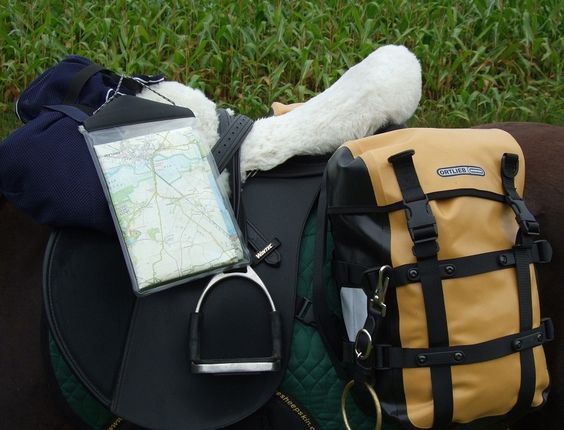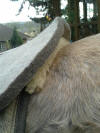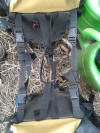Saddlebag Safety
by CuChullaine O’Reilly

|
Saddlebag Safety by CuChullaine O’Reilly
|
|
The Long Riders’ Guild receives hundreds of messages a year, each of which request advice regarding some aspect of equestrian travel. What kind of horse should I use? How many miles should I ride every day? Where will I spend the night?
These are the type of routine questions which are investigated and explained in the Horse Travel Handbook.
Yet Arthur van Vark of Australia expressed concern about a topic which other would-be equestrian travellers had failed to comment on; how to protect his horse from being injured by saddlebags.
Arthur was right to be worried because
saddlebags can wound a horse. The common cause is when friction rubs off the
hair, especially on the point of the hip joint. If the problem is not resolved,
the bag will continue to chafe until it wears a hole in the horse's flesh.
I am speaking from personal experience because I observed this problem in
Afghanistan and Pakistan. The saddlebags in those countries are made from the
same material used to weave Persian carpets. The top side of the saddle bag is a
beautiful deep red.
Though undoubtedly attractive, the back side of the saddlebag is often so abrasive that the bags frequently rub bad sores on the backs of donkeys and the hips of the horses required to carry them.
Equestrian practices differ greatly between nations and cultures. Some countries, such as the Swiss, traditionally placed the majority of weight carried by the road horse in two large leather pommel bags that rested over the equine’s powerful shoulders.
| Swiss Long Rider Otto Schwarz rode nearly 50,000 kilometres (32,000 miles) on five continents; thereby making him the most travelled Long Rider of the 20th century. He rode in a Swiss cavalry saddle made in 1913. The canvas bag in the front of the saddle holds a two day ration of grain, which is equally divided. The two pommel bags contain the essentials for horse and rider, including a spare horse shoe, eight horse shoe nails, a hoof pick and brush. A mess kit, which holds a folding canvas bucket, rests on the left side of the saddle. Otto carried a change of clothes and wash kit in the soft leather bag which rested behind the cantle. |
Yet the wisdom of the cavalry is often hard to find in the age of the internet.
In an email addressed to the Guild, Arthur explained that he had followed the example of many Long Riders who have purchased Ortlieb saddlebags (seen above). These durable saddlebags have been used in a variety of journeys.
| When Australian Long Rider Tim Cope set off in 2004 to ride 9,650 kilometres (6,000 miles) from Mongolia to Hungary, he chose to use the Ortlieb saddlebag. |
 |
Danish Long Rider Carsten Nordenhof has also used this type of waterproof saddlebag. He began his equestrian travels in 1994, when he rode from Zealand, Denmark to Santiago de Compostela, Spain. During the subsequent years, Carsten has made fourteen horse trips and ridden 35,000 kilometres (22,000 miles) through Austria, Denmark, France, Germany, Spain and Switzerland. |
These saddlebags are totally waterproof and are equipped with straps that hold the bags securely in place. What concerned Arthur in Australia was the possibility that because the bags rest behind the saddle pad, they come in direct contact with the horse’s skin. Might this result in an injury to the animal, he wondered.
Arthur wrote, “I can’t find any mention of using a special saddle blanket that is sized and shaped for the saddlebags to rest on. Or do people let the bags rest directly against the horse? I’m less than enthusiastic about that.”
In search of answers, the Guild sought the advice of German Long Rider Sabine Keller, who has used the Ortlieb saddlebags during the journeys she made across Germany, France and Spain.
|
|
Sabine is about to depart on her third journey with her Mangalarga Marchador mares Isis and Marenga. |
Though she found the Ortlieb saddlebags useful, Sabine pointed out that she takes steps to “explain the things that I do to avoid hurting the horse.”
Her first rule is to place only natural products, nothing manmade or synthetic, on the horse’s back.
“I only use only sheepskin and felt. No plastic things touch the horse’s back.”
Sabine first places a sheepskin saddle pad on her mare. The size of this pad varies in length, being 60 centimetres for a small horse and 63 centimetres for a normal horse. An important point is that the sheepskin has 3 centimetre long wool underneath.
 |
 |
 |
This sheepskin saddle pad is not only soft and durable, it provides excellent protection for the horse’s back.
“On the road I take a special small dog brush with me. I use this brush to comb out the sheepskin. This keeps the saddle pad clean and soft. Once a year I wash the saddle pad with a mild detergent designed for leather.”
Sabine notes, “It's very important to make a piece of sheepskin that covers around the ends of the saddle pad in the front and behind. You can see this in the photos.”
These two additional pieces of sheepskin provide extra protection above the withers and the spine of the horse.
The thick sheepskin pad provides a defence against the saddle, but what about the saddlebags? After riding many thousands of miles, Sabine has arrived at an answer to that problem.
The second part of the solution involves the use of a thick felt pad.
Like many experienced equestrian travellers, Sabine has learned that a saddle pad should not extend out over the hips.
“It’s not good to use a very long saddle pad. I solved this problem by placing a felt saddle pad on top of the sheepskin.”
Because the felt pad extends further back, it provides protection against the saddlebags.
Unlike a sheepskin, which retains its natural softness, felt pads can become hard when they become soaked with horse sweat. For this reason Sabine always places the felt pad on top of the sheepskin, to further protect the horse’s sensitive skin.
 |
 |
“If the felt is on top, it always stays clean and soft.”
This combination of two types of natural materials provides excellent protection for Sabine’s mare.
“I am very satisfied with my Ortlieb saddlebags. They are very water resistant and did not break while travelling,” Sabine wrote.
Yet the German Long Rider did issue a word of warning about the straps used to secure the bags.
|
|
 |
The drawing (left) shows how the Ortlieb saddlebags are normally secured. But Sabine warns that following this procedure allows the bags to hang too low, which impedes the movement of the horse’s hips.
“It is very important to change the fastening of the saddlebags. If you do not diverge from the Ortlieb instructions, the saddlebags will be placed too much on the back of the horse.”
“You can see how I fastened the saddlebags in these photos. This guarantees that the place over the hips is free of the luggage.”
 |
Using this method, the Ortlieb saddlebags are placed on top of the felt pad and do not touch the back of the horse. |
Sabine is now planning to ride “1,800 kilometres from the Germany/Poland border near the Baltic Sea, crossing all Germany from the northeast to the southwest and continue over the Vosges Mountains /France to arrive at the Equirando (biggest rider meeting in Europe with over 1.000 horses) in Bourg-en-Bresse near Lyon, France.”
Main Stories from the Road page